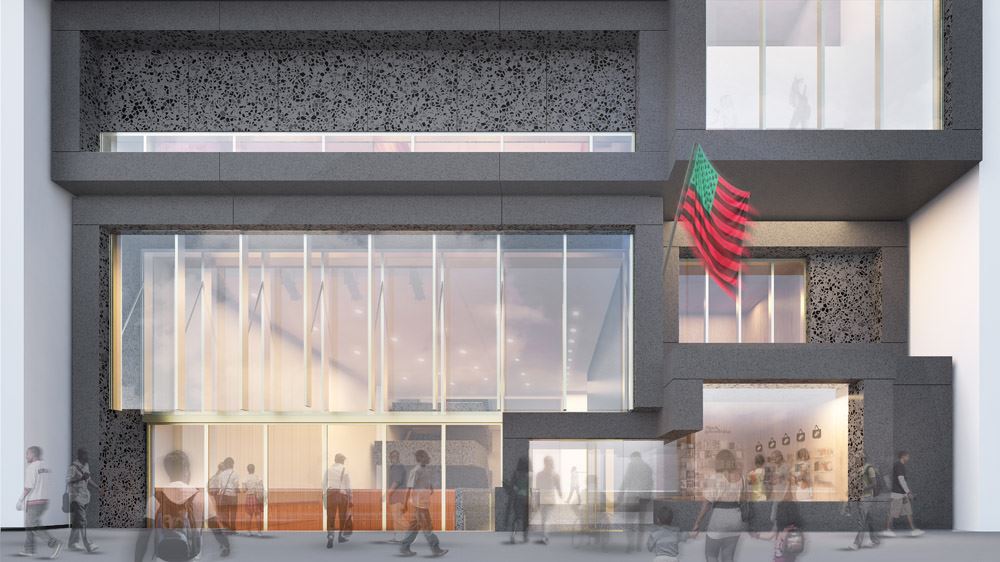After 50 years in operation, The Studio Museum in Harlem is shaking things up with a big move, heralding in a new, innovative era for the Museum.
Founded in 1968 with a mission of highlighting the work and amplifying the voices of artists of African descent, The Studio Museum has created spaces in the art world for black and African artists that were otherwise inaccessible to them. Now, the Museum is taking great strides with the construction of a brand-new building, designed by Adjaye Associates’ founder and principal architect, Sir David Adjaye OBE and the award-winning New York museum architecture firm, Cooper Robertson. The new building will celebrate the core mission of the Museum and the artists it collaborates with through specially-designed spaces.
We spoke with Alani Bass, Marketing Coordinator for The Studio Museum, about the steps the Museum has taken – and is continuing to take – to prepare for an exciting new future in Harlem.
Tell me about the construction of the new building for the Studio Museum. How did this all start?
For 50 years, The Studio Museum in Harlem has been a trailblazer in the global cultural conversation by presenting, collecting and interpreting the work of artists of African descent. However, the Museum has never occupied a space built intentionally for its programming. The Studio Museum’s new building, designed by Adjaye Associates in collaboration with Cooper Robertson, sought to create purpose-built spaces that celebrate the rich heritage of the institution, its relationship with artists and its role as a pillar of Harlem’s cultural life. Undertaken as a public-private initiative in partnership with the City of New York, the entirely new 82,000 square-foot building will be constructed on the site of our current facility, a century-old commercial building that was adapted for the Museum in the early 1980s by late African-American architect J. Max Bond Jr.

What’s going to be different about the new building? What new exhibitions/programs will be offered utilizing the new space?
The new, 82,000 square-foot Studio Museum building is designed to express the Museum’s core values of openness and engagement, while also providing exceptional new spaces to elevate the Museum’s service to artists, audiences, the uniquely vibrant Harlem community, and the world of art. Space for exhibiting and creating artworks will more than double, allowing the Museum to share even more art from the permanent collection and temporary exhibitions year-round. Visitor, public, and educational spaces will increase by nearly 50%; and outdoor space will also double.

Tell me more about the inHarlem program.
In the summer of 2016, the Studio Museum launched inHarlem, a set of collaborative programs in our neighborhood. It has been an amazing way to deepen our roots in a community that we have been a part of for fifty years, and continue our groundbreaking exhibitions, public programming, and educational art-making workshops while the building is closed for construction.
The first artists’ projects in 2016 were commissioned sculptural works by artists Kevin Beasley, Simone Leigh, Kori Newkirk and Rudy Shepherd, installed in Morningside Park, Marcus Garvey Park, St. Nicholas Park and Jackie Robinson Park. This marked the Museum’s first large-scale, public art initiative and was a partnership with New York City Parks and Historic Harlem Parks, along with the Marcus Garvey Park Alliance. Since this initial year-long project, we’ve increased programming to a variety of partner and satellite locations in Harlem, including New York Public Library branches, Maysles Documentary Center, the Schomburg Center for Research in Black Culture, and more. You can find our current inHarlem exhibitions, Firelei Báez: Joy Out of Fire and Maren Hassinger: Monuments, on view now at the Schomburg Center for Research in Black Culture and in Marcus Garvey Park, respectively.

How has the community reacted to inHarlem? To the closure of the galleries?
Our audiences have expressed great excitement for the future of the Museum. They’ve continued to support and engage with us at our various sites throughout Harlem and engagement online continues to grow! Our inHarlem programming lets our community and artists know that our work has, and always will be, for them.

What are you most excited for with everything that’s changing? What do you hope your visitors will get out of this?
I am most excited to experience the ways in which the Museum continues to grow and contribute to the rich cultural history of the community. I hope that our visitors are excited to join us on this journey of newness and change, and feel welcomed and empowered in our new home.
Words by Sarah Heikkinen. Photos courtesy of The Studio Museum in Harlem.
